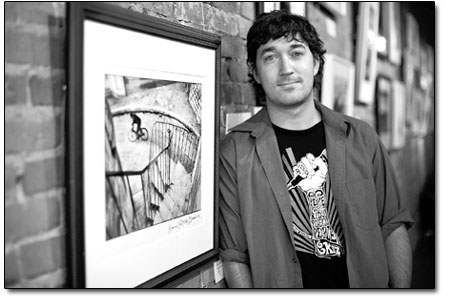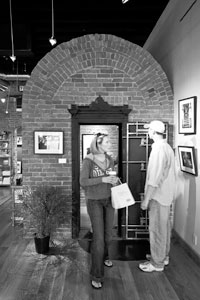| ||||
The strange and the beautiful
by Jules Masterjohn When Margy Dudley named her fine art photography gallery nearly seven years ago, she chose an identifier that relates to a universal aspect of photography – the open shutter. It is through a camera’s open shutter that light enters thus creating a photographic image. The name has another implication that Dudley may not have intended. The term “open” implies honest, approachable and exposed qualities – all apt descriptions for the photography that Dudley prefers to show at the Open Shutter Gallery. She shares this attitude of openness with her hero and French photographer, Henri Cartier-Bresson, who said, “It is in living that we discover ourselves, at the same time that we discover the world around us.” A selection of Cartier-Bresson’s photographs, along with one of his disciples, Craig Semetko, currently graces the raw brick walls of the new gallery space on Main Avenue. It was a coup for Open Shutter to secure an exhibit of such stature, and Dudley credits Gallery Manager Brandon Donahue for the success. “The opportunity to see more than 25 of Cartier-Bresson’s images all together can only be seen at New York’s Museum of Modern Art, the International Center for Photography and the Cartier-Bresson Foundation. It is a significant show and is gratifying to present the show to the community,” Donahue offered. Last year, when Dudley and Donahue were planning for their 2008 season, they looked to two publications that showcase black-and-white photography. “We were paging through B & W mag and saw this advertisement for a private collection of Cartier-Bresson’s work,” Dudley said as she flipped to the ad in the back of the magazine. Donahue proceeded to call the collector and arranged the exhibition of the famed photographer’s work, which was scheduled as Open Shutter’s grand reopening exhibit. Considered the father of candid or “street” photography, Cartier-Bresson has influenced decades of photographers through his fresh approach to photojournalism. By the time of his death in 2004, his photographs were widely collected and selling in the $10,000 range. In keeping with Open Shutter’s practice of presenting affordable photography and showcasing emerging photographers, Dudley and Donahue set out to pair Cartier-Bresson’s pictures with another photographer whose work embodies similar qualities to the master’s. In a moment of simultaneous recognition, an image by Los Angeles photographer Craig Semetko, who had stopped by the gallery a few years back, sprung into their minds. “Paris” is memorable as the hilarious portrait of a business-suited Parisian man walking down a tree-lined boulevard with a parcel of rolled up tissue paper extending from his nose. Though he “almost dropped to the floor” when he was asked to show with the heavy weight Cartier-Bresson, Semetko accepted immediately. The exhibit, “Street Photography: From Classic to Contemporary,” was born.
A stand-up comic in addition to being a photographer, Semetko writes in his artist statement, “I look for funny. If I see something that amuses me, I press the shutter. It’s that simple. If I did my job right, you can feel the delight I, myself, felt when a dapper man walked by me jauntily with what appeared to be a tampon sticking out of his nose.” “Paris” is just one of the many quirky and curious images presented by Semetko. “None of the pictures were staged,” he continues, so he must have been giddy when he saw the natural set up for his photograph, “Balloons.” Seeing this image, one wonders if the goddesses of “snap shooting” were daring him to click the shutter. Also, “Laughing Marilyn” seems like a dream come true for a street photographer or anyone who is drawn to juxtaposition, interesting compositions, humor and a bit of mystery. Capturing images that, as Dudley puts it, “bring up questions” is what Cartier-Bresson and Semetko do well. Their photographs present our humanness by exposing the private moments in which our triumphs and vulnerabilities are expressed. Cartier-Bresson’s “Barrio Chino, Barcelona, Spain, 1933” pictures a sleeping man in profile, his mouth agape, with a chalk drawing on the wall above his head that pictures a sleeping man in profile. The photographer was at the right place and time to find this delicious slice of life. His famous shot of the boy striding through a Paris street with a magnum bottle under each arm, “Rue Mouffetard, Paris, 1952,”presents an image of youthful confidence that is touching. Cartier-Bresson “prowled the streets all day, feeling very strung up and ready to pounce, determined to ‘trap’ life, to preserve the life in the act of living.” Similarly, though, with perhaps a more gentle approach, Semetko spends his days on the streets. “I’m trying to tell a story with interesting characters in a single frame. This requires a great deal of wandering around aimlessly with an empty head – a skill my teachers told me I have a gift for – only now I carry a camera to record all the strange and beautiful things that happen in front of me. In the words of my favorite photographer, Henri Cartier-Bresson, ‘Photography is nothing – it’s life that interests me.’” To learn more about the life and work of Henri Cartier-Bresson, art historian Marilee Jantzer-White will offer a lecture Fri., July 25, from 6-9 p.m. at the gallery. It is free and open to the public. • “Street Photography: From Classic to Contemporary” is on view through July 30 at the Open Shutter Gallery, 735 Main Ave., in Durango. Gallery hours are 10 a.m.-10 p.m., seven days a week.
|
In this week's issue...
- September 11, 2025
- Back on top
After harrowing flying accident, local highliner steps back out with renewed mission
- September 11, 2025
- New order
Rule change for Land and Water Conservation Fund raises alarms
- September 4, 2025
- Armed with knowledge
Local community organizers work to ensure immigrant neighbors know their rights



